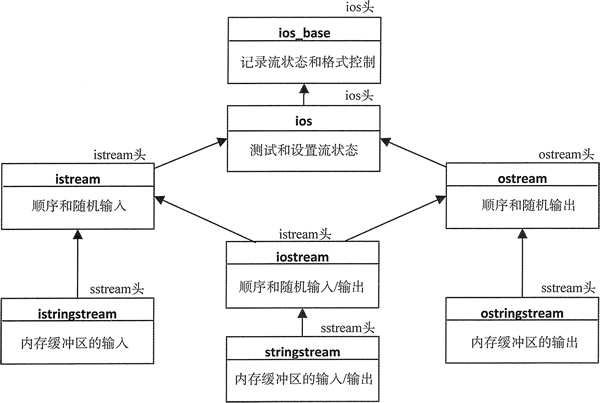string流 图片看不了?点击切换HTTP 返回上层
可以用流迭代器和流缓冲区迭代器来传送数据和读取 string 流。string 流是表示内存中字符缓冲区中的 I/O 对象,是定义在 sstream 头文件中的 3 个模板中的一个模板的实例:
字符数据类型是一个模板参数,对于 char 类型的 string 流有如下类型别名:istringstream、ostringstream 和 stringstream。这些对象的继承层次如图 1 所示。

图 1 string 流类型的继承层次
你会注意到这里的直接和非直接基类与文件流的类型是相同的,这意味着对文件流做的几乎任何事,同样也可以对 string 流做。可以用插入和提取运算符来格式化 string 流的 I/O;这意味着可以用流迭代器来读写它们。它们也支持文件流支持的无格式的 I/O 操作,因此可以用流缓冲区迭代器来读写它们。
为了保存 wchar_t 类型的字符,string 流也有一些别名,这些名称是 char 别名的名称加上前缀 'w'。只使用 char 类型的 string 流,因为它们正是通常所需要的。
要能够为内存缓冲区上的 I/O 操作提供极大的灵活性。当需要读很多次数据时,从内存缓冲区读取数据的速度要比从外部设备读取快。一个出现这种情况的场景是,当输入流的内容是变动的时。需要多次读取来确定数据是什么。可以用一个有 string 流和 string 流迭代器的代码来示范:
copy() 算法会将 dictionary.txt 的全部内容复制到一个 stringstream 对象中。复制的过程使用了流缓冲区迭代器,因此没有包含数据转换(文件的字节被复制到 instr 对象中)。当然,可以对流迭代器使用格式化的 I/O 操作,在这种情况下,复制操作将变为:
这清楚地表明流迭代器适用于 string 流对象,但比前面的版本要慢。如下是一个将文件内容复制到 stringstream 对象的更快方法:
ifstream 对象的成员函数 rdbuf() 会返回一个封装了文件内容的 basic_filebuf 对象的地址。basic_filebuf 以 basic_streambuf 为基类,并重载了插入运算符,用来将右操作数指向的 basic_streambuf 对象复制到左操作数 basic_ostream 对象中。这个操作很快,因为没有包含格式化或数据转换。
在 instr 中查找字谜和在文件流中查找是一样的,因为它是一个流(正好在内存中)。读取 string 流会移动当前位置,所以在再次读取内容时,必须调用它的成员函数 seekg() 来将位置重置为开始位置。类似地,在读到 instr 中数据的末尾时会设置 EOF 标志,必须调用成员函数 dear() 来重置这个标志。如果不这么做,随后的读操作会失败。
下面是该程序的一些示例输出:
- basic_istringstream:支持从内存中的字符缓冲区读取数据。
- basic_ostringstream:支持写数据到内存中的字符缓冲区。
- basic_stringstream:支持字符缓冲区上的输入和输出操作。
字符数据类型是一个模板参数,对于 char 类型的 string 流有如下类型别名:istringstream、ostringstream 和 stringstream。这些对象的继承层次如图 1 所示。

图 1 string 流类型的继承层次
你会注意到这里的直接和非直接基类与文件流的类型是相同的,这意味着对文件流做的几乎任何事,同样也可以对 string 流做。可以用插入和提取运算符来格式化 string 流的 I/O;这意味着可以用流迭代器来读写它们。它们也支持文件流支持的无格式的 I/O 操作,因此可以用流缓冲区迭代器来读写它们。
为了保存 wchar_t 类型的字符,string 流也有一些别名,这些名称是 char 别名的名称加上前缀 'w'。只使用 char 类型的 string 流,因为它们正是通常所需要的。
要能够为内存缓冲区上的 I/O 操作提供极大的灵活性。当需要读很多次数据时,从内存缓冲区读取数据的速度要比从外部设备读取快。一个出现这种情况的场景是,当输入流的内容是变动的时。需要多次读取来确定数据是什么。可以用一个有 string 流和 string 流迭代器的代码来示范:
1 2 3 4 5 6 7 8 9 10 11 12 13 14 15 16 17 18 19 20 21 22 23 24 25 26 27 28 29 30 31 32 33 34 35 36 37 38 39 40 41 42 43 44 45 46 47 48 49 50 | // Using a string stream as the dictionary source to anagrams of a word#include <iostream> // For standard streams#include <fstream> // For file streams#include <iterator> // For iterators and begin() and end()#include <string> // For string class#include <set> // For set container#include <vector> // For vector container#include <algorithm> // For next_permutation()#include <sstream> // For string streamsusing std::string;int main(){ string file_in {"G:/Beginning_STL/dictionary.txt"}; std::ifstream in {file_in}; if(!in) { std::cerr << file_in << " not open." << std::endl; exit(1); } std::stringstream instr; // String stream for file contents std::copy(std::istreambuf_iterator<char>{in}, std::istreambuf_iterator<char>(), std::ostreambuf_iterator<char>{instr}); in.close(); // Close the file std::vector<string> words; string word; auto end_iter = std::istream_iterator<string> {}; // End-of-stream iterator while(true) { std::cout << "\nEnter a word, or Ctrl+z to end: "; if((std::cin >> word).eof()) break; string word_copy {word}; do { instr.clear(); // Reset string stream EOF instr.seekg(0); // String stream position at beginning // Use find() to search instr for word if(std::find(std::istream_iterator<string>(instr), end_iter, word) != end_iter) words.push_back(word); // Store the word found std::next_permutation(std::begin(word), std::end(word)); } while(word != word_copy); std::copy(std::begin(words), std::end(words), std::ostream_iterator<string>{std::cout, " "}); std::cout << std::endl; words.clear(); // Remove previous anagrams }} |
1 | std::copy(std::istream_iterator<string>{in},std::istream_iterator<string>(),std::ostream_iterator<string>{instr, " "}); |
1 | instr << in.rdbuf(); |
在 instr 中查找字谜和在文件流中查找是一样的,因为它是一个流(正好在内存中)。读取 string 流会移动当前位置,所以在再次读取内容时,必须调用它的成员函数 seekg() 来将位置重置为开始位置。类似地,在读到 instr 中数据的末尾时会设置 EOF 标志,必须调用成员函数 dear() 来重置这个标志。如果不这么做,随后的读操作会失败。
下面是该程序的一些示例输出:
Enter a word, or Ctrl+z to end: part
part prat rapt tarp trap
Enter a word, or Ctrl+z to end: painter
painter pertain repaint
Enter a word, or Ctrl+z to end: ^Z
